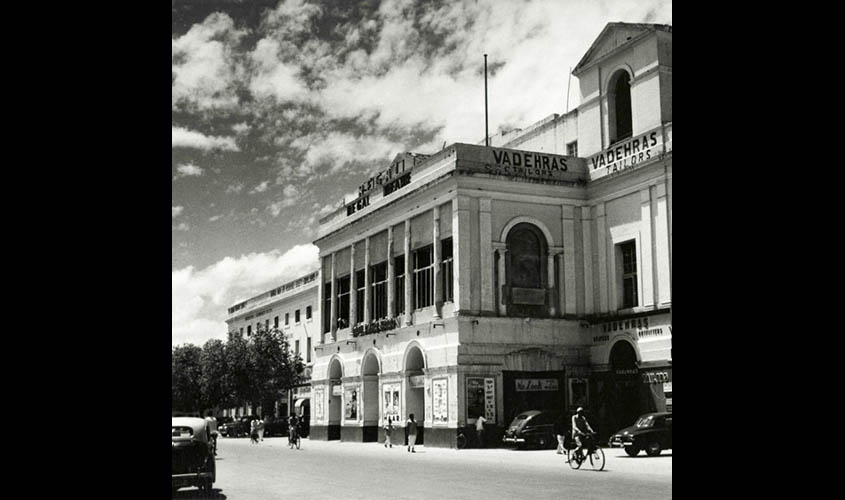For someone like me, who was either born in the national capital or grew up here, there are certain defining landmarks of the city and there is no denying that Regal Cinema and Building is one of the most notable amongst them. Therefore, when the management of this iconic institution decided to order its closure following irreconcilable differences in the extended Dayal family, as well as the fact that there were limitations of financial resources to upgrade it in its present form, it came as a rude shock. It is apparent that there are indelible memories related to this particular cinema hall, which also served as a theatre to host plays by famous British groups such as Geoffrey Kendal’s Shakespeareana and our own Prithvi Theatres, founded by Prithviraj Kapoor. It is well known that visiting groups from Britain would take singular pride in performing here and at the Gaiety Theatre in Shimla, the two most well known platforms for staging plays in the colonial era.
Delhi University’s former Dean of Cultural Affairs, Prof Sydney Rebeiro recounts having witnessed magic shows in the 1950s so as to illustrate that Regal was more than a cinema hall. It had the most structured seating arrangement, which enabled viewers occupying any seat to have an equally good view of the screen. This was obviously because the seating was designed keeping in mind the demands of staging plays. Raj Kapoor, due to his father’s long-standing association with the theatre, made it a point to ensure that all his productions were screened at Regal and at Moti Cinema in Chandni Chowk. No wonder the curtain closed with the final bow to the country’s greatest showman by screening his magnum opus, Mera Naam Joker and the path-breaking Sangam as the final two films on its last day.
Delhi, undoubtedly, is an exceptionally historic city. However, Regal building and the cinema symbolised its changing face after the British decided to make it their capital. Horse carriages and later cars would stop in the porch for cinegoers to alight and proceed inside through a majestic staircase leading to its balcony. The cinema complex had the well known Standard restaurant on one side, where the novelty was a juke box. In addition, espresso coffee accompanied with brownie biscuits were served in the restaurant, and Regal’s snack bar was known for its piping hot and sumptuous samosas, carted in from the walled city, as well as its indigenous wafers.
Interestingly, Regal always remained the most significant part of Connaught Place till it was disconnected from the inner circle due to the construction of the underground Palika Bazar, which encroached upon the parking area coming up on the site of the Indian Coffee House and the Theatre Communication building, around which many state emporia flourished.
Sadly, Regal’s closure reflects the graphically changing character of Connaught Place, where well known establishments are giving way to hookah bars and eateries and businesses which defy the very nature of what was once a culturally rich shopping complex. In the Regal building itself, the internationally acclaimed Gaylord restaurant has ceased to exist and many years before that shutters too were pulled down on Davicos. The corner of the building with its inter-section with Parliament Street was often called Delhi’s “Scandal Point”, inspired by how a particular place on the Mall in Shimla was referred to due to an interesting anecdotal history attached to it. The folklore was that one would run into people one had not met in years at this spot of the building.
India’s first discotheque, The Cellar, was opened at one end, along with a quaint cafe named the Parlour in the mid 1960s. School kids and collegiates would consider it an extraordinary privilege to go to The Cellar, where loud music and a dance floor beckoned them. The Parlour was sombre and solemn and this is where Delhi’s top student leaders, regardless of their political affiliations, would spend their evenings, sipping coffee and discussing current affairs. Finance Minister Arun Jaitley was a regular and so were pro Congress leaders like Rohit Bal Vohra, Deepak Malhotra and Bahadur Singh, besides socialists such as Raj Kumar Jain, Lalit Mohan Gautam and Gopi Manchanda. At that time, Jaitley’s political mentor, Shriram Khanna was ever present and so was Mujib, a former president of Jamia Millia Islamia who would play a most gracious host.
The Regal building’s prominence was also highlighted by the presence of the Kwality restaurant towards Parliament Street and not to forget the western music shop, A. Godin and Sons. Gainda Mull Hemraj, a department store, with branches in Shimla and other places and a tobacconist were its integral part as was the Tea House next to Gaylords where horse racing enthusiasts would catch up on the latest betting.
Viewing a movie at the cinema meant that one could absorb the entire experience of being in Connaught Place in its entirety. A stroll in any direction showed different shades of CP. Crossing the outer circle towards the Coffee House would lead to Delhi’s first open air drive-in restaurant, The Ramble, known for its burgers and soft drinks. The winding up of Regal amplifies the fact that Connaught Place will never be the same again. Between us.

